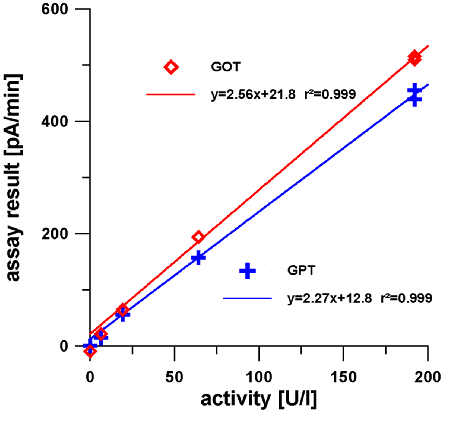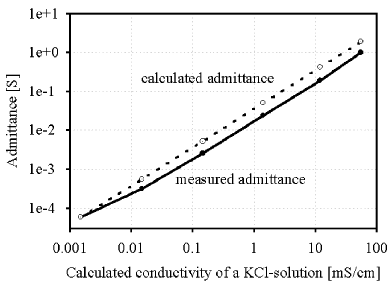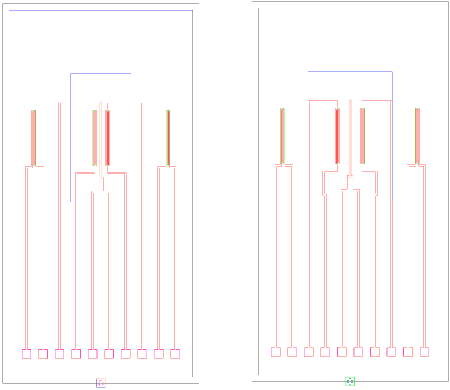
Integrated Sensor-Microflow-Systems
G. Urban, F. Kohl, A. Jachimowicz, J. Steurer, F. Keplinger,
P. Svasek, E. Svasek
Institut für Allgemeine Elektrotechnik und Elektronik, TU Vienna
A-1040 Wien, Austria
This report describes first experiences with a new high resolution, miniaturized optical pH sensor principle we developed and presents results obtained for a novel biosensor for liver enzymes assay and a wide range conductometric sensor. The integration of those sensors, among others, on a common carrier requires advanced integrated sensor-microflow-systems. This topic is addressed by an experimental study on different miniaturized fluidic mixer structures and the investigation of miniaturized flow sensors using a new signal conditioning device.
Introduction
Modern medical research and intensive care requires very complex biochemical analysis to be done e.g. at the patient’s bedside. This task necessitates small sensors as well as cheap and handy equipment. Integrated sensor-microflow-systems address those technical needs. To build up effective integrated analysis systems there is a variety of essential prerequisites like miniaturized sensors, bioreactors, actuators, and valves. Beside these miniaturized components there must exist adequate techniques to interconnect these essential components.
Experimental
A Novel Thin Film Integrated Optics pH Sensing System
By combining an ultrathin photopatterned pH dependent swelling membrane with a replicated chirped grating coupler as a transducer an optical pH sensor was created.
The pH sensitive membrane is made from a poly(80 mol% Hydroxyethyl methacrylate – 20 mol% N,N’ Dimethylaminopropyl methacrylate) copolymer. With a pK value of 7.5 the pendant amino groups become protonated. This leads to an increase of the osmotic pressure in the gel that increases the swelling and, due to the relative lower refractive index of water, the gel’s refractive index decreases. A polymer solution, comprising benzoquinone as photoactive agent, is applied to the substrates by spin coating to produce layers of 100 nm thickness. Benzoquinone forms a charge transfer complex with the amino groups of the polymer which facilitates crosslinking upon UV exposure. This makes it possible to pattern this "negative working" membrane precursor with a mask aligner at one minute exposure time.
The replicated chirped grating couplers, which are contributed by the Paul Scherrer Institute Zurich, are made on polycarbonate with a TiO2 waveguide and two chirped gratings. Since the grating periodicity continuously varies at chirped gratings, the coupling criterion is matched only on one point. In this way, changes in the refractive index are related to moves of the emitted light point at the outcoupling grating. Such devices showed a resolution of 10-4 pH units and response times of less then one minute. Because of the relatively easy and potentially cheap manufacturing, their planarity, and sensitivity, they are attractive candidates for microphysiometry applications. Even quantification of single cell metabolic activity seems feasible.
Rapid Liver Enzyme Assay with Bioanalytical Microsystem
Assays of transaminases present in the serum play an important role in diagnosis and monitoring of the course of liver diseases or myocardial infarction. Elevated serum activity of GOT – Glutamic Oxaloacetic Transaminase – indicates severe damage to the cells of heart or liver. Especially in the early detection of myocardial infarction monitoring of GOT during the first 24 hours helps to gain an insight into the seriousness of the infarction. GPT – Glutamic Pyruvic Transaminase – is present in high concentrations only in the cytosol of hepatocytes. Therefore raised plasma activity of GPT indicates a severe liver disease like viral hepatitis or toxic liver necrosis causing disruption of cell membranes.
The realized amperometric assay detects the transaminase acivities by detecting the product glutamate by means of a thin film glutamate biosensor. Production and performance of the thin film biosensor array are described by Moser et al. [1]. The sensor array comprising two glutamate sensors and two blank sensors is 4x7 mm2 wide and made by means of thin film technology. The transaminase activity assaying device comprises of the thin film biosensor array assembled on a microfluidics realized with the dry film photoresist technology (see 2.5). This integration not only minimizes the sample volume required but also increases the reliability of the analysis performed.

Fig. 1: Calibration graphs of GPT and GOT assays.
Experimental ResultsThe calibration graphs of the GOT and GPT assays are shown in Fig. 1. Increased activity of the enzyme in the range of 100 – 200 U/l indicates most of the liver diseases [1]. Compared to the traditional spectrophotometric techniques of transaminase acivity assays this novel analytical device offers serious advantages. Most important, readout can be obtained within a few minutes. Sample volume requirement is reduced, too. No NADH and no soluble enzymes are required in the assay and therefore the stability of the substrate solutions is enhanced. The small dimensions of the device, the stability of the reagents used, and the relatively simple measurement electronics should allow the development of a hand-held device for the point of care assay of GOT and GPT.
Miniaturized Planar Four Electrode Conductometric Sensors
Conductometric transducers covered with functional membranes will become important transducers in medical, biological, and environmental diagnostics. We studied planar devices featuring structure widths of 2 µm and 5 µm (Fig. 2) and two as well as four electrode arrangements. The results of impedance measurements obtained with these were compared with simulation results for the voltage-current relations. Measurements using two and four electrode techniques were carried out. The voltage applied at the current terminals of such transducers must not exceed 10 mVeff to prevent electrochemical reactions, and the useful frequency ranges from 100 Hz to some 10 kHz.

Fig. 2: Electrode structures used for the experiments and the simulations. Interdigital distances typical 2 to 5 µm, overall area 2 by 2 mm2.
With shrinking structure widths the limited rate of charge transfer between the electrodes and the electrolyte becomes of main importance. For two-electrode impedance measurements they put severe limits on the measurable ion concentration ranges and the maximum operating frequency. By using four-electrode techniques one can extend the measuring range far beyond these limits if signals in the 1 µV range are acceptable.
For miniaturized structures the large relative width of the voltage measuring electrodes causes deviations near the surface from the ideal electric field configuration of four probe arrangements. Also the influence of the electrolyte layer thickness, which is determined by the dimensions of the miniaturized flow channel cross section, have to be taken into account. Because of the lateral channel dimensions and the periodicity of the electrode arrangement a two-dimensional model of the electrolyte cell geometry was chosen for all numerical simulations which were carried out using the ANSYS software packet.
Measurement ResultsA comparison of measured and calculated admittance values shows good consistence of the concentration dependency, leading to a extremely wide useful measuring range of 0.001 mS/cm to 100 mS/cm (Fig. 3). As long as the electrolyte resistance doesn’t dominate the over-all resistance the calculated admittance of the model is significantly higher than the measured quantity, indicating that the model assumes too high values for the charge transfer rates at the electrodes.

Fig. 3: Comparison between calculated and measured admittance of a four-electrode transducer.
Controlled intermixture of reagents or the addition of small amounts of drugs during infusion calls for miniaturized flow sensors. Hot film flow sensors based on thin-film amorphous germanium thermistors offer quick response, high sensitivity, recognition of flow direction, and a wide dynamic range. Integration of these thermistors on a micromachined thin membrane could further enhance their sensitivity and, as a benefit from miniaturization, give a faster response to flow changes. Flow direction could be recognized using two temperature sensors placed on the membrane symmetrically to a thin-film platinum resistor that sources the heat. Figure 4 shows a realized structure of a micromachined flow sensor which comprises two substrate thermistors that can be used to eliminate the influence on sensor performance of ambient temperature changes.

Fig. 4: Mask layouts of two different miniaturized flow sensor structures. The micromachined membrane area, defined by the smallest rectangles, bears two flow sensing thermistors and an intermediate metal film resistor. Two additional thermistors serve for substrate temperature monitoring.
Flow Measurement ResultsA constant temperature difference between the ambient and the average temperature of the membrane thermistors was maintained by an electronic controller. The signal was derived from the temperature difference at the membrane thermistors sites. An investigation of the transducer mounted to a flow channel of 0,5 mm2 cross sectional area delivered a useful measuring range from 200 µl/h to 200 ml/h for the volume flux of water. That measuring range should be sufficient for nearly all medical applications. The corresponding detection limit for the volume flux of air was 1,3 ml/h for the same arrangement. This are reasonable good results for a transducer optimized for short response time rather than maximum flow sensitivity.
The observed response time of 1 ms is in good agreement with the predictions of FE model calculations. The output power of the controller could be used as a measure for the magnitude of the flow velocity, too. But in this operation mode the recognition of the direction of flow is not possible. A linear response to the flow was obtained at full bandwidth by digitizing the sensor signals and using a look-up table transformation.
Dry Resist Miniaturized Mixing Devices
Three different types of miniaturized mixer structures have been fabricated by means of dry film photoresist technology [2]. Enhanced mixer performances using specially designed microstructures were compared with that of a smooth channel, which is 600 µm wide, 100 µm high and 170 mm long.
The second type of micro-mixer consists of a channel of the same dimensions but with additional diagonal grooves in the bottom. These grooves add a rotational movement to the stream.
The so-called Moebius principle has been applied for the third mixing device. The basic element of a Moebius mixer performs rotation, splitting the flow, separate rotation and recombination. Rotation is achieved by groups of fins at the bottom of the channel.
Measurement and ResultsThe mixing behavior was made visible using solutions of iodine-starch blue and Na thiosulfate, which decolorizes the first one by chemical reaction. Complete mixing takes a considerably long time in a smooth channel and therefore very low flow rates have to be used. Grooves improved the mixing performance roughly by an order of magnitude. The improved performance of the Moebius type of mixers is very impressive. Complete mixing occurs at considerably higher flow rates and takes much less time, while the internal volume is even lower.
|
type of mixer |
internal volume |
complete mixing at |
mixing time |
|
smooth channel |
10.2 µl |
£ 0.12 µl/min |
85 min |
|
channel with 164 diagonal grooves |
16.3 µl |
£ 1.3 µl/min |
12.5 min |
|
4-stage Moebius mixer |
6.5 µl |
£ 285 µl/min |
1.4 s |
Table 1: Performances of different types of static mixers
Conclusion
Our recent developments of sensors extend the field of metabolics measurable by microsensors. The progress of cheap integration technologies enables complete integrated sensor-microflow systems to be built. We have shown that this concept works well by the new transaminase assay, which is based on a specific implementation of the integrated sensor-microflow-system concept.
Acknowledgments
Part of this work was supported by the Brite Euram program of the European Community, the companies AVL and Schlumberger Paris, and the Forschungsförderungsfonds der gewerblichen Wirtschaft.
References
[1] I. Moser, G. Jobst, E. Aschauer, P. Svasek, M. Varahram, G. Urban, V. Zanin, G. Tjoutrina, A. Zharikova, T. Berezov: "Miniaturized Thin Film Glutamate and Glutamine Biosensors", Biosensors & Bioelectronics 10, (1995) 527 – 532.
[2] P. Svasek, G. Jobst, G. Urban, E. Svasek: "Dry Film Resist Based Fluid Handling Components for µTAS", Proc. 2nd Intern. Symposium on Micro Total Analysis Systems µTAS96, Basel, Switzerland, 1996, 78 – 80.
Project Information
Project Manager
Univ. Doz. Dr. Gerald Urban, Dr. Franz Kohl
Institut für Allgemeine Elektrotechnik und Elektronik, TU Wien
Project Group
|
Last Name |
First Name |
Status |
Remarks |
|
Biacovsky |
Dalibor |
dissertation |
|
|
Fasching |
Rainer |
dissertation |
|
|
Jachimowicz |
Artur |
assistant professor |
1.1.1997 – 30.9.1997 |
|
Jobst |
Gerhard |
technician |
|
|
Keplinger |
Franz |
assistant professor |
partially GMe funded |
|
Kohl |
Franz |
assistant professor |
|
|
Moser |
Isabella |
post doc |
1.1.1997 – 31.8.1997 |
|
Steurer |
Johannes |
assistant professor |
partially GMe funded |
|
Svasek |
Peter |
technician |
|
|
Svasek |
Edeltraut |
technician |
|
|
Urban |
Gerald |
associate professor |
1.1.1997 – 31.3.1997 |
|
Vahraram |
Mehdi |
dissertation |
Books and Contributions to Books
Publications in Reviewed Journals
Doctor’s Theses
Cooperations